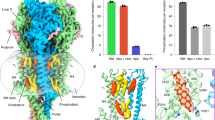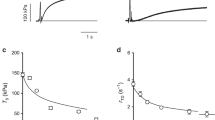Abstract
MANY polyvalent cations have been used in studies of synaptic transmission either as tools for gaining a better understanding of synaptic processes or, in their own right, as potentially toxic substances1–7. Inorganic lead although long known to have neurotoxic effects, has not been studied extensively at the synaptic level until recently. Kostial and Vouk8 found that lead blocked transmission in the perfused superior cervical ganglion of the cat in vitro by reducing the amount of acetylcholine released from presynaptic nerve terminals without affecting the response of ganglion cells to applied acetylcholine. The addition of excess calcium to the perfusion solution restored acetylcholine output and relieved the lead block. Manalis and Cooper9, working with the frog sciatic nerve-sartorius muscle preparation in vitro, showed that lead depresses phasic transmitter release evoked by nerve stimulation and increases spontaneous release as evidenced by an increase in frequency of miniature endplate potentials. Lead had only a weak, curare-like effect on the postsynaptic response to applied acetylcholine. In this paper we show, using electrophysiological techniques, that PbCl2 blocks synaptic transmission pre-synaptically by competitive inhibition of calcium. In support of this data, we further show, using 45Ca, that lead in fact does reduce the uptake of calcium by preganglionic nerve terminals.
This is a preview of subscription content, access via your institution
Access options
Subscribe to this journal
Receive 51 print issues and online access
$199.00 per year
only $3.90 per issue
Buy this article
- Purchase on Springer Link
- Instant access to full article PDF
Prices may be subject to local taxes which are calculated during checkout
Similar content being viewed by others
References
Weakly, J. N., J. Physiol., Lond., 234, 597–612 (1973).
Meiri, U., and Rahamimoff, R., Science, 176, 308–309 (1972).
Guerrero, S., and Riker, W. K., J. Pharmac. exp. Ther., 186, 152–159 (1973).
Manalis, R. S., and Cooper, G. P., Nature, 257, 690–691 (1975).
Kostial, K., and Landeka, M., Experientia, 31, 834–835 (1975).
DeBassio, W. A., Schnitzler, R. M., and Parsons, R. L., J. Neurobiol., 2, 263–278 (1971).
Del Castillo, J., and Engback, L., J. Physiol., Lond., 124, 370–384 (1954).
Kostial, K., and Vouk, V. B., Br. J. Pharmac., 12, 219–222 (1957).
Manalis, R. S., and Cooper, G. P., Nature, 243, 354–356 (1973).
Koketsu, K., and Yamamoto, K., Br. J. Pharmac., 50, 69–77 (1974).
Dodge, F. A., and Rahamimoff, R., J. Physiol., Lond., 193, 419–432 (1967).
Dunant, Y., and Dolivo, M., Brain Res., 10, 268–270 (1968).
Blaustein, M. P., Science, 172, 391–393 (1971).
Carroll, P. T., Silbergeld, E. K., and Goldberg, A. M., Neurosci. Abstr., 1, 250 (1975).
Goyer, R. A., and Mahaffey, K. R., Environ. Hlth Perspect., 2, 73–80 (1972).
Author information
Authors and Affiliations
Rights and permissions
About this article
Cite this article
KOBER, T., COOPER, G. Lead competitively inhibits calcium-dependent synaptic transmission in the bullfrog sympathetic ganglion. Nature 262, 704–705 (1976). https://doi.org/10.1038/262704a0
Received:
Accepted:
Issue Date:
DOI: https://doi.org/10.1038/262704a0
This article is cited by
-
Decreased thiamine and magnesium levels in the potentiation of the neurotoxicity of lead in occupational lead exposure
Biological Trace Element Research (2007)
-
Alterations in calcium homeostasis on lead exposure in rat synaptosomes
Molecular and Cellular Biochemistry (1994)
-
Evaluation ofDrosophila melanogaster as an alternative animal for studying the neurotoxicity of heavy metals
Biometals (1992)
-
Effect of lead on cardiac parasympathetic function
International Archives of Occupational and Environmental Health (1991)
-
Organic and inogranic lead inhibit neurite growth in vertebrate and invertebrate neurons in culture
In Vitro Cellular & Developmental Biology (1989)
Comments
By submitting a comment you agree to abide by our Terms and Community Guidelines. If you find something abusive or that does not comply with our terms or guidelines please flag it as inappropriate.



